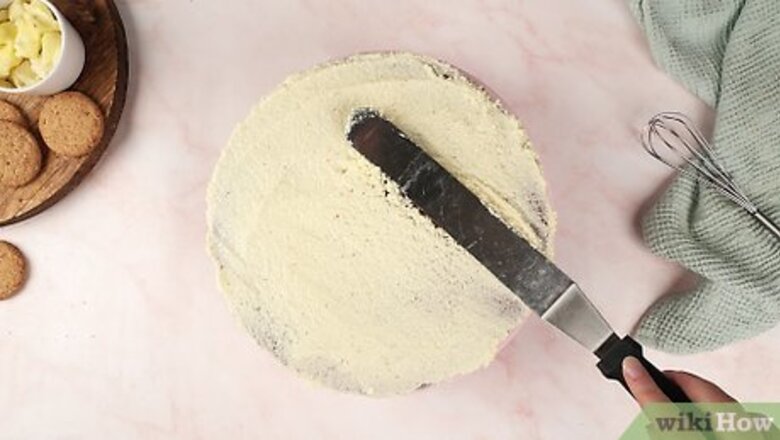
views
Covering a Cake With Fondant
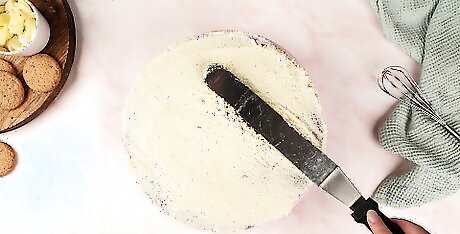
Frost your cake with buttercream. Set your cake on a work surface like parchment paper or a silicone mat. Make sure the top of the cake is level before you begin. Frost the top and sides of your cake with a buttercream frosting of your choice. Using an all-butter buttercream will help the fondant stick to your cake and can hide imperfections in the baked cake. You may want to place the cake on a lazy susan so you can frost it while rotating it.
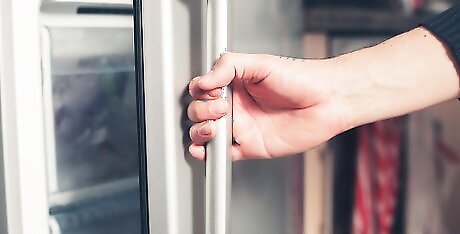
Refrigerate the frosted cake. Move the frosted cake to the fridge for 15 to 20 minutes. The buttercream frosting should set up so the surface is firm and easy to work with. Just make sure you have enough space in your refrigerator to set the cake so that things in your fridge don't bump or jostle the cake. If you live in a warm climate or it's a hot time of year, you may need to refrigerate your cake longer. Keep it in the refrigerator until the frosting has hardened a little and your finger doesn't leave an impression when you touch it.
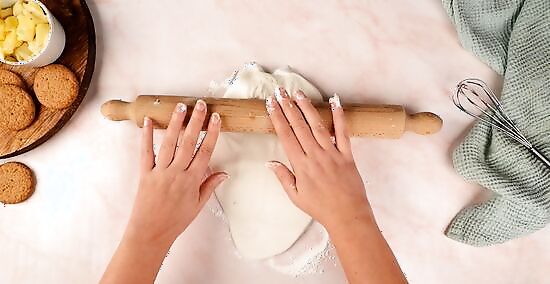
Knead and roll out the fondant. Take your ready-made fondant icing and knead it with your hands till it's pliable like a dough. Dust your work surface with cornstarch or powdered sugar and set the fondant on it. Use a heavy rolling pin and roll the fondant out in all directions. Lift up the fondant every few turns to make sure it's not sticking to your work surface. If it is, scatter a little more cornstarch or powdered sugar. Continue rolling until you reach the size you need for your cake. Always roll more fondant than you'll actually put on your cake. For example, for a double-layered 8" cake, you'll need to roll out 2 1/2 pounds of fondant, but will only use 1 1/2 pounds. If you notice tiny air bubbles, carefully pop them using a needle or pin. Kneading is important to break down sugar crystals in the fondant which will give it a smooth texture.

Drape the fondant over a rolling pin or long cylinder. Remove your frosted cake from the refrigerator and spray it all over with fresh water. This will help the fondant stick to the cake and keep it from drying out. Gather up your thinly rolled fondant by holding a light rolling pin or long cylinder a few inches above the center of your fondant. Use your other hand and carefully drape half of the fondant over the rolling pin so it drapes down onto the other side. You could also lift and transfer the fondant with your hands, but you risk tearing the fondant by handling it more. Using a rolling pin or cylinder will also ensure that the cornstarch side remains on the bottom. This way, the shiny side will be exposed on the top and sides of your cake.
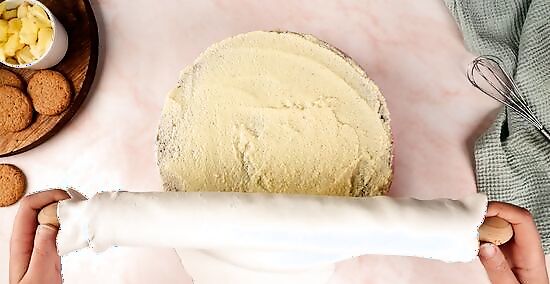
Drape the fondant over the cake. Hold the rolling pin with fondant over the center of your cake and lower it towards the cake. Unroll the fondant off the rolling pin so it gradually falls across the entire cake. The fondant should cover the top and extend down and past the sides of the cake.

Smooth the fondant. Use a plastic fondant smoother tool and gently rub or buff the sides of the cake covered in fondant. Apply gentle pressure as you work around the entire side of the cake. This will smooth out any irregularities in the fondant while helping it stick to the cake. It may help to have the cake on a lazy suzan while you smooth the sides of the cake.

Trim the fondant. Take a sharp pizza cutter and trim the fondant along the base of the cake. Be sure to leave a very little bit of an edge (about 1/4") so you can make sure you have enough fondant on the sides of the cake. Smooth the sides of the cake again and re-trim the bottom, cutting right along the base of the cake this time. Take this time to check over the cake for any air bubbles. If you find them, pop them with pins or a fine needle. Use your finger to gently smooth out the mark left by the pin.
Making and Effectively Using Fondant Decorations

Create a fondant rose. Pinch off a few coin-sized pieces of fondant and set them on a sheet of wax paper. Set one ball of fondant on the end of another sheet of wax paper and fold the opposite end of paper over the ball. Squish the ball with the wax paper and use your finger to smooth out one tip of the squished fondant. This will make the tip of your rose petal. Do this for all the balls to make petals. To assemble the rose, roll one petal into a cylinder and begin applying the petals to the base of the cylinder till you shape a rose. The more pieces you use, the more petals you'll make. Roll each piece into a ball.

Make fondant lace. Buy a lace stencil from any craft supply or cake supply store. Roll out your fondant into a large rectangle so that it's thin. Set the stencil over your fondant. Use a small rolling pin to firmly press against the fondant while you roll across the stencil. Remove the stencil. You should see the appearance of the lace impressed on the fondant. The thinner you roll the fondant, the more delicate the lace will appear. Make sure your stencil stays in place as you roll the fondant or the lace pattern will blur.

Try fondant bows. Roll fondant into a rectangular shape so it's 1/8" thin and cut it into short strips. Each one of these strips will make a loop in the bow so cut as many as you'd like. Take a strip and fold it over so you can pinch the ends. Set the loop aside to dry for a few days. Do this for all of your strips. To assemble the bow, squirt a little melted chocolate or royal icing on a piece of wax paper. Set the loops into this edible glue, turning some loops on their sides. Continue placing all the loops until your loops resemble a bow. Let the bow dry overnight. If the ends of a strip won't pinch together, moisten an end with a little water. This time, the strip should stay together. Add more melted chocolate or royal icing if you make multiple rows of loops in your bow.
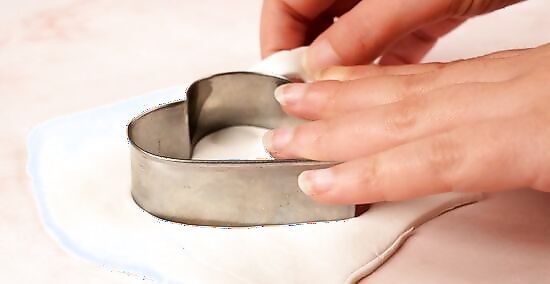
Stamp out fondant shapes. Roll out your fondant till it's the thickness you want. Take a cookie cutter in the shape you'd like to make and stamp down into your fondant. Repeat this until you've cut as many shapes as you like. You can use a variety of shapes or try using one shape, but making different colors. You can also buy specially designed fondant cutters that are more detailed than traditional cookie cutters.

Color your fondant. Dip a toothpick into icing color of your choice. Dab the toothpick onto your fondant before you roll it out. Knead the fondant until the icing color is evenly distributed and the color is uniform. Go back and add more icing color if you want a brighter color. Remember that some colors (pink and violet) will fade under fluorescent lights and in sunlight. To create a marbled look, dab the toothpick with icing color onto the fondant. Hold the fondant with both hands.Twist and knead the fondant only a little, so that the colors marble.
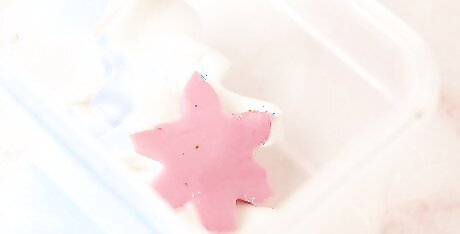
Store your fondant decorations before using them. If you're making your fondant decorations even a little in advance, they may droop or fall by the time you're ready to serve the cake. To remove the moisture that causes this drooping, let your decorations dry in at least overnight (or up to 2 days) in a muffin tin. If you don't like the idea of drying and storing your fondant decorations, consider using gum paste instead of fondant. Gum paste is easier to use when rolling out flowers and they'll store longer without drooping.
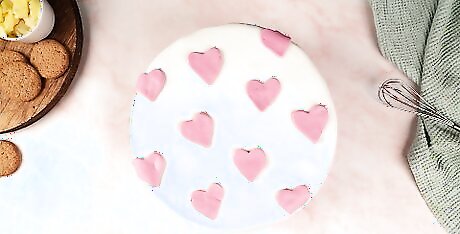
Attach the fondant decorations to your cake. Depending on the shape of your decoration, you may be able to insert it and apply it using buttercream. For example, if you have balls of fondant that you want to apply to the base of your cake, pipe a row of buttercream and press the balls into the frosting to anchor them. Or if you're working with thinly rolled decorations, you can brush the backs with water and apply them directly to the fondant covered cake. For example, if you're applying stamped fondant decorations, brush the backs with water using a pastry brush. Immediately position them onto your cake so they dry onto the fondant of the cake.




















Comments
0 comment